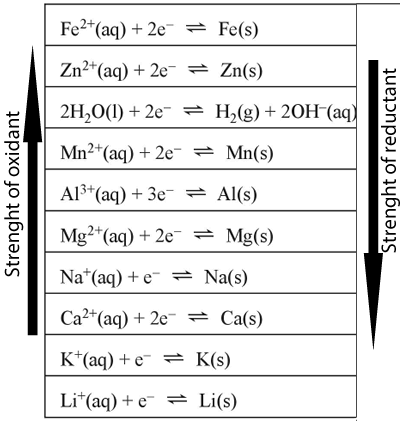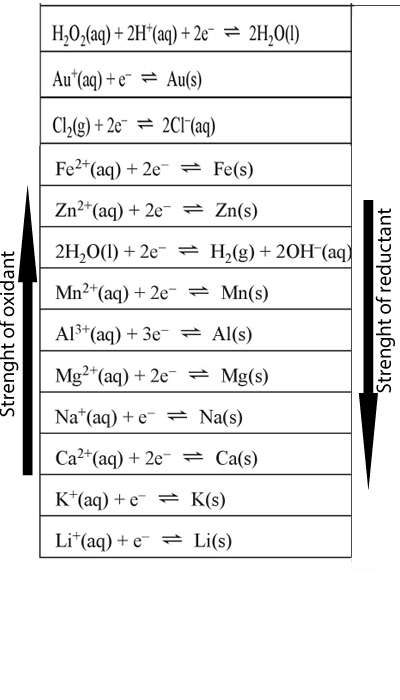Predicting spontaneous
redox reactions.

For convenience a table of oxidants and their conjugate reactants when placed in order of strength can be used to predict if a spontaneous reaction will occur between an oxidant and a reductant. This table is known as the electrochemical series and is provided in the data sheet. A section of the electrochemical series is shown on the left.
It is worth noting that although the electrochemical series will help predict if a spontaneous reaction will occur it does not predict the rate at which the reaction will occur.
To predict the likelihood of a spontaneous reaction follow the steps as outlined in the animation below.

Example
Will a spontaneous reaction occur when Magnesium metal is added to 1.00M Fe2+ solution? If so write the overall redox equation for the reaction.
Follow the steps below. Click on the blue steps.
Step 1 Identify all the oxidants and reductants present in the reaction mixture.
Step 2 Identify the strongest oxidant
and strongest reductant present.
- Magnesium metal is the strongest reductant and appears on the right of the series.
-While Fe2+ is the strongest oxidant and appears on the left of the series.
Step 3 For a spontaneous reaction to occur the strongest reductant must be below the strongest oxidant on the electrochemical series. Otherwise we can not proceed to step 4 as no reaction will occur spontaneously.
Step 4 Write the reduction reaction, this is the one that contains the oxidant, as it is on the electrochemical series. Then write the reduction equation, that is the one that contains the reductant, in the reverse order.
Step 5 Multiply each equation as needed to make the electrons given equal the electrons taken. This step may not always be needed if the electrons are already equal.
Step 6 Add the reduction and the oxidation half equations and cancel the electrons.
1. Predict if a spontaneous redox reaction will occur between the following reactants. If a spontaneous reaction will occur, write its overall reaction.
a) Au+(aq) and Mg(s) ---------- Solution
b) Au+(aq) and Fe(s) ---------- Solution
c) Water and K+ ions ---------- Solution
d) Water and calcium metal. ---------- Solution
e) Lithium metal placed in water ---------- Solution
f) Zinc metal placed in a solution of LiNO3 ---------- Solution
g) Gold metal and a solution of Ca(NO3)2 ---------- Solution
2. Potassium metal (K(s)) is placed in a solution of Mg2+ ions.
Will a spontaneous reaction take place?
If so predict the possible products by writting the overall balanced equation. If not explain why. ---------- Solution
3. A spontaneous reaction occurs when magnesium metal is placed in a neutral, dilute solution of Al(NO3)3 . Predict how the pH of the solution will change and justify your answer with reference to the products formed. ---------- Solution
